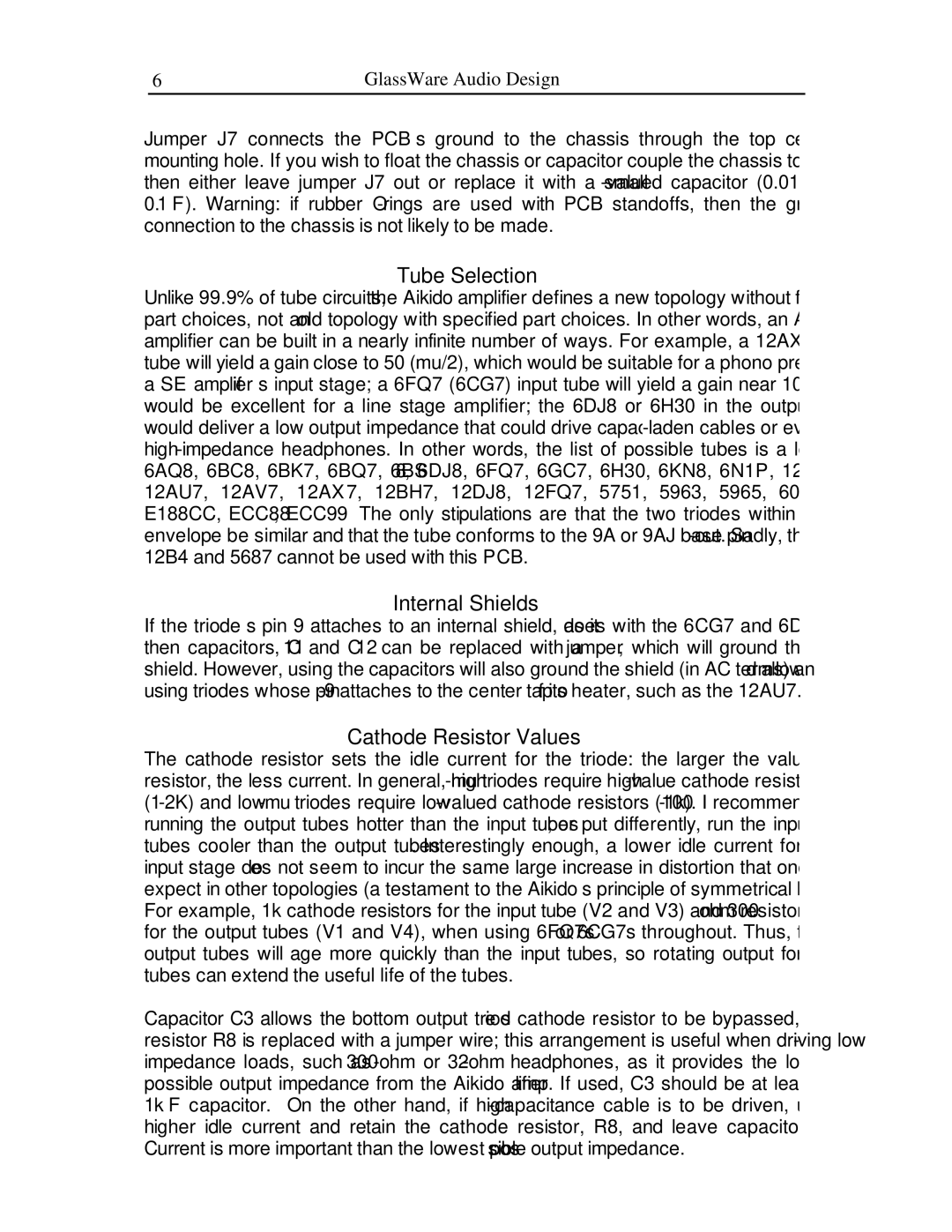Jumper J7 connects the PCB’s ground to the chassis through the top centermost mounting hole. If you wish to float the chassis or capacitor couple the chassis to ground, then either leave jumper J7 out or replace it with a small-valued capacitor (0.01 to 0.1µF). Warning: if rubber O-rings are used with PCB standoffs, then the ground connection to the chassis is not likely to be made.
Tube Selection
Unlike 99.9% of tube circuits, the Aikido amplifier defines a new topology without fixed part choices, not an old topology with specified part choices. In other words, an Aikido amplifier can be built in a nearly infinite number of ways. For example, a 12AX7 input tube will yield a gain close to 50 (mu/2), which would be suitable for a phono preamp or a SE amplifier’s input stage; a 6FQ7 (6CG7) input tube will yield a gain near 10, which would be excellent for a line stage amplifier; the 6DJ8 or 6H30 in the output stage would deliver a low output impedance that could drive capacitance-laden cables or even high-impedance headphones. In other words, the list of possible tubes is a long one: 6AQ8, 6BC8, 6BK7, 6BQ7, 6BS8, 6DJ8, 6FQ7, 6GC7, 6H30, 6KN8, 6N1P, 12AT7, 12AU7, 12AV7, 12AX7, 12BH7, 12DJ8, 12FQ7, 5751, 5963, 5965, 6072, 6922, E188CC, ECC88, ECC99… The only stipulations are that the two triodes within the envelope be similar and that the tube conforms to the 9A or 9AJ base pin-out. Sadly, the 12B4 and 5687 cannot be used with this PCB.
Internal Shields
If the triode’s pin 9 attaches to an internal shield, as it does with the 6CG7 and 6DJ8, then capacitors, C11 and C12 can be replaced with a jumper, which will ground the shield. However, using the capacitors will also ground the shield (in AC terms) and allow using triodes whose pin-9 attaches to the center tap of its heater, such as the 12AU7.
Cathode Resistor Values
The cathode resistor sets the idle current for the triode: the larger the value of the resistor, the less current. In general, high-mu triodes require high-value cathode resistors (1-2K) and low-mu triodes require low-valued cathode resistors (100-1k). I recommend running the output tubes hotter than the input tubes; or put differently, run the input tubes cooler than the output tubes. Interestingly enough, a lower idle current for the input stage does not seem to incur the same large increase in distortion that one would expect in other topologies (a testament to the Aikido’s principle of symmetrical loading). For example, 1k cathode resistors for the input tube (V2 and V3) and 300-ohm resistors for the output tubes (V1 and V4), when using 6FQ7s or 6CG7s throughout. Thus, the output tubes will age more quickly than the input tubes, so rotating output for input tubes can extend the useful life of the tubes.
Capacitor C3 allows the bottom output triode’s cathode resistor to be bypassed, when resistor R8 is replaced with a jumper wire; this arrangement is useful when driving low- impedance loads, such as 300-ohm or 32-ohm headphones, as it provides the lowest possible output impedance from the Aikido amplifier. If used, C3 should be at least a 1kµF capacitor. On the other hand, if high-capacitance cable is to be driven, use a higher idle current and retain the cathode resistor, R8, and leave capacitor C3 off. Current is more important than the lowest possible output impedance.
